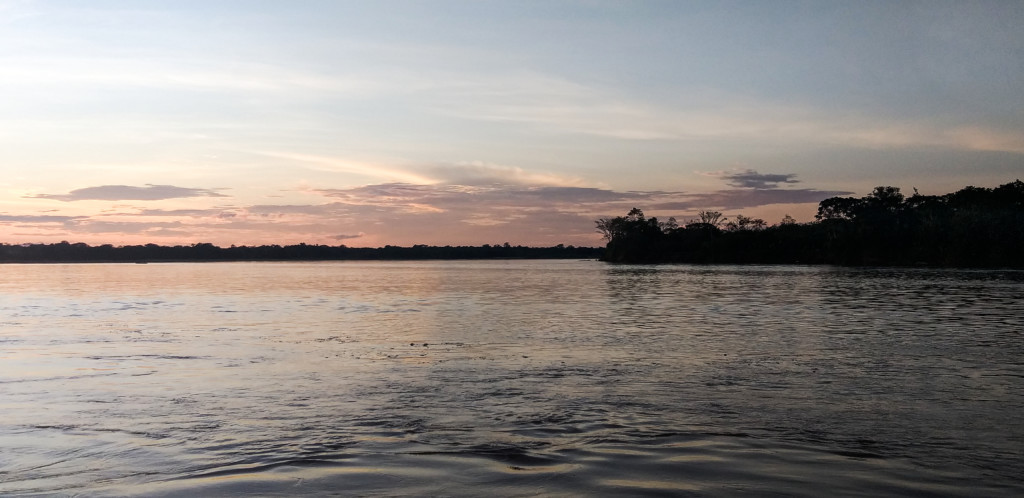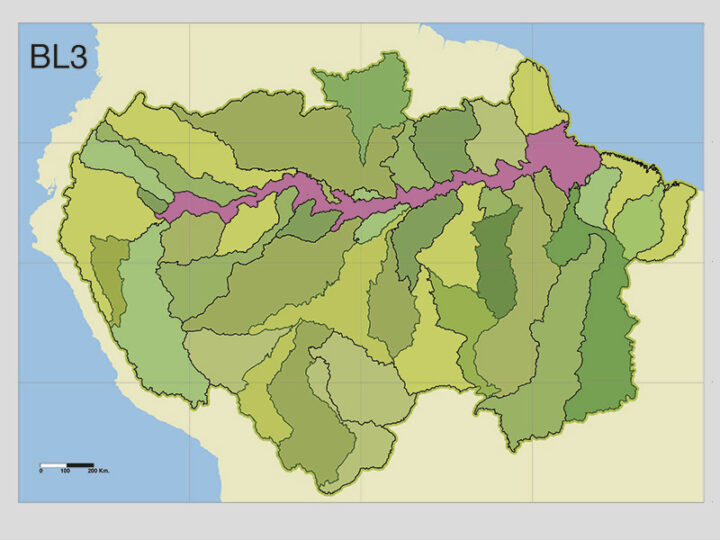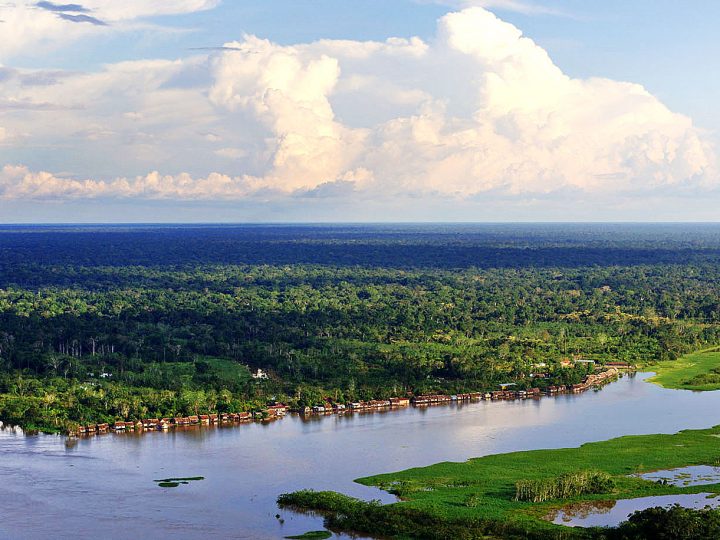
 In Colombia there are more than 48 thousand wetlands that represent about 26 percent of its continental territory. Photography: Colombian Amazon Region-Carolina Obregón Sánchez.
In Colombia there are more than 48 thousand wetlands that represent about 26 percent of its continental territory. Photography: Colombian Amazon Region-Carolina Obregón Sánchez.
Colombia is a country with more than 48 thousand wetlands that represent about 26 percent of its continental territory. Part of its history is linked to these ecosystems that since ancient times have defined not only the amphibious nature of their soils, but also that of indigenous peoples, farmers or Afro-descendants, that is, they are amphibious cultures. However, nowadays 24.2 percent of these wetlands are transformed by livestock, agriculture and deforestation, and by an urban and construction process unknown to them for decades: in large cities such as Bogotá, for example, there were close to 50 thousand hectares of wetlands 60 years ago, of which only 727 hectares remain due, in part, to the fact that entire neighborhoods have been built on them.
Although this country has a National Wetlands Policy (since 2002) and different standards, management plans and projects that support the management of wetlands, there are several challenges that must be overcome to achieve an adequate management of these ecosystems; such as large-scale planning, making visible the close relationship between wetlands and human activities or strengthening governance at different levels.
Integrate other approaches
Wetlands are highly dynamic ecosystems that depend on equally dynamic natural and anthropic processes: the elements that define them are climate, water levels in rivers, the water cycle, the state of forests, soils, or biodiversity, or human beings and their activities. Until now, the study and management of wetlands in Colombia was done from specific approaches (hydric, hydrological, biological, ecological, etc.) that were unaware of this dynamic.
Although progress has been made in integrating different approaches both in wetland research and management, Sandra Vilardy, who holds a doctorate in ecology with extensive experience in wetland ecology, assures that it is necessary to strengthen the understanding of these ecosystems from their different dimensions (biological, ecological, water, hydrological, etc.) and scales (starting from local areas to regional or cross-border), but from a comprehensive perspective.
“There are no minor issues or topics. Some approaches are purely hydric, others hydrological, others ecological, and all are key to understanding how a wetland works; but it is necessary to start observing them on a larger scale in order to foresee the possible conflicts that may be generated by planning that excludes some of them”, states Wilson Ramírez, coordinator of the Biodiversity Territorial Management Program at the Alexander von Humboldt Biological Resources Research Institute (from which restoration processes of this country wetland areas have been carried out). In this country there are experiences in different wetland areas, such as Magdalena-Cauca or La Mojana, in which management has ignored, for example, the socio-ecological character of wetlands, that is, the relationship between natural resources and human populations, generating conflicts over the use of water or soil or fishing resources, explains Wilson Ramírez.
Wetlands are socio-ecological systems in which the natural environment-human population relationship is decisive: these ecosystems provide food for self-consumption or wood to build houses or serve as natural transportation routes, they also define ways of life and well-being of many human populations, at the same time that they are transformed by them. It has been and will continue to be so. Hence, integrating other approaches (such as Nature-Based Solutions) that take this relationship into account, in addition to the multidimensional and multiscale view, is a challenge in wetland management.
Promoting knowledge
In Colombia, wetlands are a little-known ecosystem, in fact, they are understood as “simple natural ecosystems” or are seen as “flooded areas that hinder development”. Sandra Vilardy explains that technical-scientific knowledge about these ecosystems tends to “remain within the heart of institutions” in technical reports or scientific articles that few know about, when one of the greatest challenges is that this knowledge transcends not only the common citizen but to those entities and people who are in charge of environmental or territorial planning or organization. In Colombia there are more and more people, from different disciplines, interested in providing solutions that consider the complexity of wetland areas, as well as the transformations that have occurred and are occurring due to issues such as climate change, explains the researcher, who adds that “the greatest challenge is that time is breathing down our necks and a new awareness of what is happening is urgent.”
What IPBES did– collecting global information on biodiversity and ecosystem services and putting it together and analyzing it to present a current picture – is a good example of how knowledge can be spun and explained to be useful, says Vilardy. But if it is about reaching those who make decisions about environmental, economic, development or land use policies (national, regional or local governments, for example) or those who implement the actions derived from said policies (technical, industrial sectors or communities with whom interventions are carried out), this is an exercise that can and should also be enriched with the transfer of knowledge and the installation of technical capacities. To reach the common citizen, there are currently many tools to share knowledge about the country’s wetlands. Social networks or digital media, for example, are platforms through which the story of wetlands can be told and the way in which they have influenced the amphibious nature of the country, its transformations and the pressures they face due to human activities.
 The challenges in wetland management in Colombia are similar to those in other countries: addressing wetlands on a large scale, strengthening governance at different levels or greater compression of water and its natural cycles are some of them. Photography: Walter Wust.
The challenges in wetland management in Colombia are similar to those in other countries: addressing wetlands on a large scale, strengthening governance at different levels or greater compression of water and its natural cycles are some of them. Photography: Walter Wust.
Strengthen governance
“There is a challenge in the current management of wetlands, which is an ethical challenge, and it is to understand the dignity of the people who depend on their wetlands. From the big cities of the country we do not realize how much rural communities depend on these ecosystems for their well-being”, says Sandra Vilardy.
In this sense, Wilson Ramírez affirms that the management of wetlands must be approached in a transversal way in which the governance of these communities is strengthened; “The management of wetlands implies a transversal and shared responsibility by the different actors in the territory, from national to local levels,” he explains. Although there is a government level that is key in this management, there is also a responsibility of the academic sector to support from science to decision-making, through information that allows identifying the impacts (positive and negative) on wetland areas and projecting possible future impacts and the possible transformations and adaptations that may occur, and there is a responsibility of the industrial sectors and their activities, and there is an individual responsibility regarding consumption habits (finally we all make direct or indirect use of these ecosystems), and there is a responsibility of local communities to exercise their governance.
The challenge is to understand that this is a shared responsibility in which each one, from their role, supports a shared management model, taking into account the importance of wetlands for the good living of these communities.
A common agenda
 Despite being one of the most productive ecosystems in the world, wetlands are also one of the most transformed by human activities. Photography: Colombian La Mojana -Carolina Obregón Sánchez region.
Despite being one of the most productive ecosystems in the world, wetlands are also one of the most transformed by human activities. Photography: Colombian La Mojana -Carolina Obregón Sánchez region.
Wetlands are among the most productive ecosystems in the world, but also among the most threatened on the planet, which is why both Sandra Vilardy and Wilson Ramírez agree that the importance of consolidating an agenda for their management is a challenge that should not be delayed. This means strengthening, coordinating and harmonizing the different management agendas of these ecosystems to consolidate and enhance a national (and global) agenda that promotes a type of management that integrates the challenges mentioned above: scientific research, knowledge dissemination, transfer capacities, governance at different levels. But, the specialists state, it is a long-term agenda that should focus on solutions to current problems such as adaptation and mitigation of climate change, water pollution that affects fishing and agricultural productivity, rehabilitation and conservation of wetlands or the loss of biodiversity.
The large-scale impacts on wetlands can be explained by the fact that everything that happens thousands of kilometers away causes damage that is now evident. However, the solutions that are proposed and implemented, not only thousands of kilometers away but in an comprehensive way, can also mark the protection, conservation, management and good management of these ecosystems in Colombia, which is an amphibious country.
—
Written by Carolina Obregón
Sources consulted:
-Sandra Vilardy Quiroga, Marine Biologist, Doctor in ecology and environment, and researcher on topics related to the analysis of socio-ecological systems. She is currently the Director of Parques Cómo Vamos.
-Wilson Ramírez Hernández, Doctor in Ecology with an emphasis on restoration ecology. He is the main author of the restoration chapter of the United Nations Intergovernmental Platform for Biodiversity and Ecosystem Services, and advised the concept document of the National Restoration Plan of the Environment and Sustainable Development Ministry of Colombia.
–Wetlands for the people. Sandra Liliana Mosquera, Olga Nieto and Carlos Tapia Caicedo. Alexander von Humboldt Biological Resources Research Institute, 2015.



